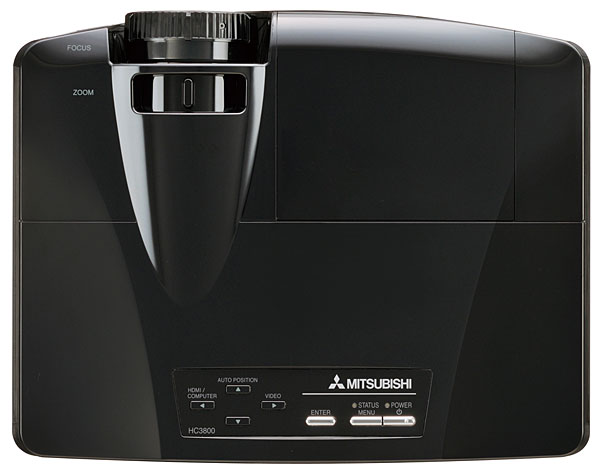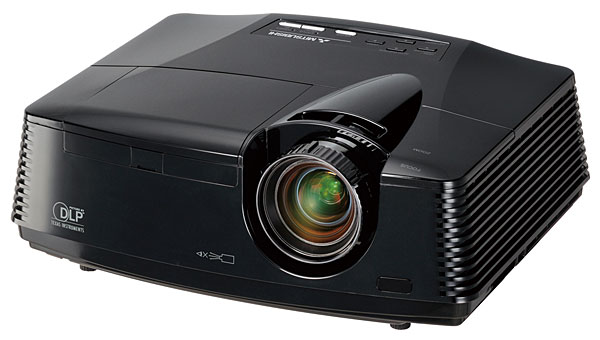Mitsubishi HC4000 DLP Projector Page 2
Setup
Like virtually all projectors in this price range, the HC4000 does not provide lens-shift controls, which move the lens up and down and left and right. Without these controls, you are very limited in where you can place the projector in relation to the screen. The ideal placement is to mount it upside down from the ceiling with the lens axis (an imaginary line through the center of the lens) pointed at the top of the screen; if you put it on a table or stand, the lens axis must be pointed at the bottom of the screen, which means people in the room can easily block the image.
If you must place the projector so the lens axis is not at a right angle to the screen, its vertical-keystone control can square up the image. (There is no horizontal-keystone control, so the lens must be horizontally centered on the screen.) However, engaging keystone also reduces resolution dramatically, and I do not recommend it if you can possibly avoid it.

As usual, I started by setting the basic picture controls (Brightness, Contrast, Color, Tint, and Sharpness). At the maximum Contrast setting that didn't clip above-white, the peak-white level was way too high on my 75-inch-wide screen, even in Low lamp mode. So I backed it off until the peak-white level was around 16 foot-lamberts, where it should be for a completely dark room. This means the HC4000 will work well on a larger screen in Low lamp mode and an even larger screen in Standard lamp mode.
Setting the Sharpness control to 0 made the image look a bit soft, while anything above 1 induced severe edge-enhancement. A setting of 1 looked very good—nice and sharp without edge enhancement.
Performance
I started my real-world watching with Master and Commander on Blu-ray. The blacks were appreciably deeper than I've seen on other low-cost projectors up to now—still not super deep, but better. Shadow detail in the opening below-deck walk by the watchman at night was not great, with some low-level details lost in solid dark gray.
The same was true of The Matrix on Blu-ray—the shadow detail in the opening scene and in Neo's apartment was only so-so. Overall detail was very sharp and crisp in the cables and other equipment on the bridge of the Nebuchadnezzar and in the rough-textured clothing in the real world. Skin tones in the computer-generated world were a bit pinker with the CMS turned off, but the movie has a distinct greenish cast in that world, and skin tones looked more natural in the real world with the CMS on.
In the episode called "The Inner Light" from the new Star Trek: The Next Generation Blu-ray, skin tones and other colors looked more natural with the CMS on—even Data's white complexion looked a bit pinkish without the CMS. The black of space was not terribly deep, but overall detail in the texture of clothes, hair, and plaster on buildings was exquisite—perhaps a little too sharp, as I could easily see spots where some of the prosthetics were attached in Patrick Stewart's old-man makeup.
The Art of Flight is an exceptional Blu-ray that documents the adventures of some extreme snowboarders, and it looked spectacular on the Mitsubishi. Detail in snow-covered trees and mountains was stunning, and colors were gorgeous, such as the blue sky and brightly colored clothes and helicopters.

Turning to DVDs, I played a bit of The Fifth Element Superbit edition. The overall detail was as good as can be expected from DVD, though the shadow detail in the opening shot of the spaceship approaching Earth was pretty poor. In the first shots of the evil planet, it's nearly invisible against the black of space, which isn't all that deep. On the plus side, the color of skin tones as well as Korben's orange shirt and yellow cab were great. Likewise, the riotous colors of Moulin Rouge on DVD were beautiful, but the shadow detail in Christian's apartment at night was not, with lots of low-level things missing in the dark-gray fog.
Bottom Line
Overall, the Mitsubishi HC4000 produced the most pleasing, enjoyable picture I've seen from a projector costing less than $1,500. Its detail and color are top-notch, and it offers many advanced features, including a color-management system that actually improves the color performance—a rarity in my experience.
Perhaps even better, its black level is lower than any other budget projector I've tested, though still not low enough to compete with many models in the next higher price tier (around $3,000). And shadow detail is definitely lacking, which detracts from an otherwise beautiful image in dark scenes. Still, if your projector budget can't exceed $1,500, the HC4000 is the best bet I've found so far.























































